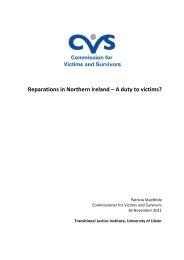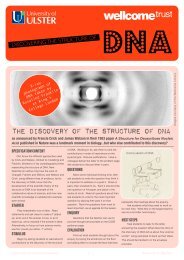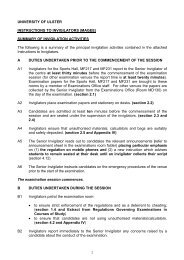Agreement Reached in the Multi-Party Negotiations - Transitional ...
Agreement Reached in the Multi-Party Negotiations - Transitional ...
Agreement Reached in the Multi-Party Negotiations - Transitional ...
You also want an ePaper? Increase the reach of your titles
YUMPU automatically turns print PDFs into web optimized ePapers that Google loves.
Promotion: With<strong>in</strong> <strong>the</strong> Police Service, females are under represented at all ranks, <strong>in</strong><br />
particular at command level. This is not surpris<strong>in</strong>g given <strong>the</strong> low number of females<br />
recruited <strong>in</strong> <strong>the</strong> past. Reasons identified are reticence, career gaps, and motivation. The<br />
report recommends an analysis to establish if <strong>the</strong>re is a significant disparity between <strong>the</strong><br />
length of service of male applicants and female applicants for promotion and between <strong>the</strong><br />
success rates of <strong>the</strong> respective genders and a quantitative and qualitative study of female<br />
officers to <strong>in</strong>vestigate attitudes towards promotion, obstacles aga<strong>in</strong>st go<strong>in</strong>g for promotion<br />
and factors considered prior to opt<strong>in</strong>g to apply for promotion.<br />
Retention: It is recommended that managers/commanders look favourably on requests<br />
for more flexible and variable work patterns; that work/life balance enquiries are given due<br />
consideration and attempts made to facilitate such requests wherever possible- all requests<br />
should by copied to <strong>the</strong> Equality/Diversity Unit.<br />
Resolution/Industrial Tribunal: It is recommended that all staff attend<br />
harassment/bully<strong>in</strong>g tra<strong>in</strong><strong>in</strong>g and receive and acknowledge receipt of <strong>the</strong> Grievance<br />
Procedure and Harassment and Bully<strong>in</strong>g policy.<br />
Network<strong>in</strong>g: Whilst each recommendation is specifically address<strong>in</strong>g a s<strong>in</strong>gle issue <strong>the</strong><br />
overall objective is to create a culture that tackles any underly<strong>in</strong>g or un<strong>in</strong>tentional bias<br />
aga<strong>in</strong>st female officers. It is <strong>the</strong>refore recommended that that an overarch<strong>in</strong>g action should<br />
be to establish greater opportunities for <strong>in</strong>ternal/external network<strong>in</strong>g for female officers<br />
thus enabl<strong>in</strong>g <strong>the</strong>m to establish alternative frames of reference, which will enhance <strong>the</strong>ir<br />
ability to adopt a different perspective and contribute to organisational change.<br />
Recommendations – mentor<strong>in</strong>g scheme; awareness rais<strong>in</strong>g; sem<strong>in</strong>ars; workshops; meet<strong>in</strong>g<br />
to assess <strong>in</strong>terest with<strong>in</strong> Crim<strong>in</strong>al Justice sector of feasibility of establish<strong>in</strong>g a women’s<br />
network with<strong>in</strong> <strong>the</strong> Crim<strong>in</strong>al Justice field.<br />
Civilians: Civilians form 31.6% of permanent PSNI workforce; females are 67.4%. Whilst<br />
mak<strong>in</strong>g up <strong>the</strong> majority, a greater percentage of females are employed <strong>in</strong> <strong>the</strong> lower grades<br />
of staff. It is recommended that gender issues are given significant consideration as <strong>the</strong><br />
Police Service cont<strong>in</strong>ues to exam<strong>in</strong>e opportunities to have all staff recognised as direct<br />
recruits by 2010. This requires a significant m<strong>in</strong>dset shift for <strong>the</strong> organisation.<br />
An implementation group will cont<strong>in</strong>ue to meet on a regular basis to ensure that all actions<br />
are be<strong>in</strong>g implemented.<br />
9.8.6 PSNI and Domestic Violence<br />
Polic<strong>in</strong>g Plan 2003-2006: ‘To report <strong>the</strong> number of domestic violence offences and<br />
develop a strategy for monitor<strong>in</strong>g <strong>the</strong> disposal of <strong>in</strong>cidents’. In 2004 <strong>the</strong> number of<br />
<strong>in</strong>cidents reported were 16, 926 compared to 15,512 <strong>the</strong> year before – an <strong>in</strong>crease of 9.1%.<br />
Domestic violence offences rose from 7,961 to 8,565 <strong>in</strong> 2003-04, an <strong>in</strong>crease of 7.6%. 306<br />
‘PSNI has developed a strategy to monitor <strong>the</strong> disposal of domestic violence <strong>in</strong>cidents.’ 307<br />
Compare <strong>the</strong>se figures with Women’s Aid statistics for 2002-2003: 17,580 calls to Helpl<strong>in</strong>e<br />
for advice on domestic violence. 989 women and 1,112 children were accommodated <strong>in</strong><br />
Women’s Aid refuges. The number of women that used local outreach centres was 4,451<br />
and six women were killed as a result of domestic violence.<br />
306 Nor<strong>the</strong>rn Ireland Polic<strong>in</strong>g Board Annual Report 2004<br />
307 Ibid.<br />
67
















